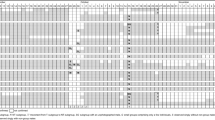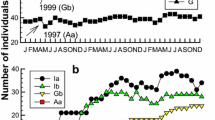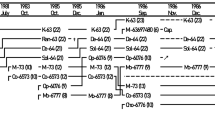Abstract
A population of rhesus monkeys (Macaca mulatta)at Tughlaqabad on the southeastern outskirts of New Delhi has grown rapidly in the past 4 years, and the largest group (Group A) has given rise to three smaller groups. Fissioning, or new group formation, was not consistently associated with any particular season of the year or stage of the reproductive cycle, but it did occur in each case when the parent group reached approximately 120 monkeys. The fissioning process was not preceded or accompanied by unusual aggressive behavior. It occurred quietly and appeared to be a loss of cohesion within the large group by which a subgroup achieved behavioral and spatial independence. Some aggressive interactions did occur following each fission when the new group approached or attempted to reenter the parent group. Each newly formed group was subordinate to the parent group and all other groups in the population.
Similar content being viewed by others
References
Altmann, J. (1974). Observational study of behavior: Sampling methods.Behaviour 49: 227–267.
Chepko-Sade, B. D., and Sade, D. S. (1979). Patterns of group splitting within matrilineal kinship groups: Study of social group structure inMacaca mulatta (Cercopithecidae, Primates).Behav. Ecol. Sociobiol. 5: 67–86.
Hrdy, S. (1984). Personal communication.
Malik, I. (1983).A Study of Selected Behavioral Traits of Rhesus Monkeys (Macaca mulatta)in Free-Ranging Environments, Ph.D. thesis, University of Meerut, Meerut.
Malik, I., Seth, P. K., and Southwick, C. H. (1984). Population growth of free-ranging rhesus monkeys at Tughlaqabad.Am. J. Primatol. 7: 311–324.
Marsden, H. M. (1971). Intergroup relations in rhesus monkeys (Macaca mulatta). In Esser, A.H. (ed.),Behavior and Environment: The Use of Space by Animals and Men, Plenum Press, New York.
Missakian, E. A. (1973). The timing of fission among free-ranging rhesus monkeys.Am. J. Phys. Anthropol. 36: 621–624.
Prakash, I. (1960). Breeding of mammals in the Rajasthan desert, India.J. Mammal. 41: 386–389.
Prakash, I. (1962). Group organization, sexual behavior and breeding season of certain Indian monkeys.Jap. J. Ecol. 12: 83–86.
Sade, D. S. (1980). Population biology of free-ranging rhesus monkeys on Cayo Santiago, Puerto Rico. In Cohen, M., Malpass, R.S., and Klein, H.G. (ed.),Biosocial Mechanisms of Population Regulation, Yale University Press, New Haven, Conn.
Seth, P. K., and Seth, S. (1983). Population dynamics of free ranging rhesus monkeys in different ecological conditions in India.Am. J. Primatol. 5: 61–67.
Southwick, C. H., and Siddiqi, M. F. (1983). Twenty-year changes in rhesus monkey populations in agricultural areas of northern India.Ecology 64: 434–439.
Southwick, C. H., Beg, M. A., and Siddiqi, M. R. (1965). Rhesus monkeys in north India. In DeVore, I. (ed.),Primale Behavior: Field Studies of Monkeys and Apes, Holt, Rinehart and Winston, New York.
Southwick, C. H., Siddiqi, M. F., and Oppenheimer, J. R. (1983). Status and conservation of rhesus monkeys in India. In Seth, P.K. (ed.),Perspectives in Primate Biology, Today and Tomorrow’s Publishers, New Delhi.
Tiwari, K. K. (1983). Report on population census of rhesus macaque and Hanuman langur of India. Zoological Survey of India, Calcutta (mimeo).
Author information
Authors and Affiliations
Rights and permissions
About this article
Cite this article
Malik, I., Seth, P.K. & Southwick, C.H. Group fission in free-ranging rhesus monkeys of Tughlaqabad, Northern India. Int J Primatol 6, 411–422 (1985). https://doi.org/10.1007/BF02736387
Received:
Revised:
Issue Date:
DOI: https://doi.org/10.1007/BF02736387




